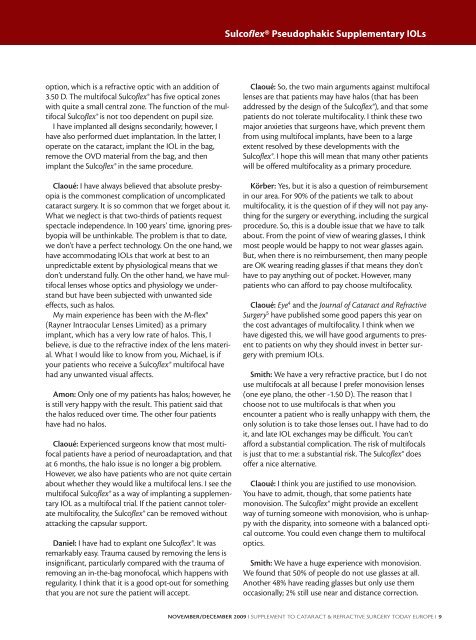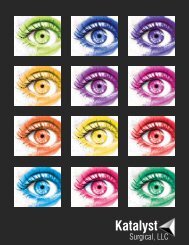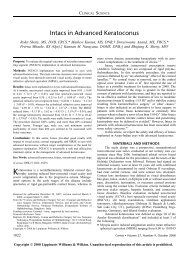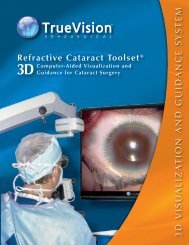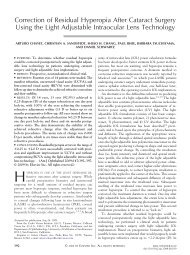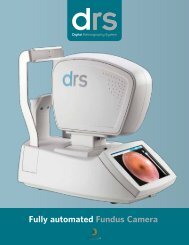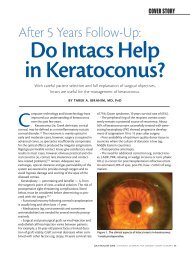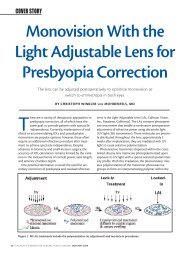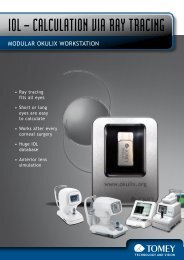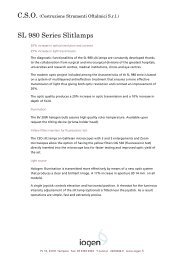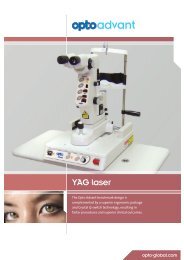Sulcoflex ®Pseudophakic Supplementary IOLs - Iogen
Sulcoflex ®Pseudophakic Supplementary IOLs - Iogen
Sulcoflex ®Pseudophakic Supplementary IOLs - Iogen
Create successful ePaper yourself
Turn your PDF publications into a flip-book with our unique Google optimized e-Paper software.
option, which is a refractive optic with an addition of<br />
3.50 D. The multifocal <strong>Sulcoflex</strong>® has five optical zones<br />
with quite a small central zone. The function of the multifocal<br />
<strong>Sulcoflex</strong>® is not too dependent on pupil size.<br />
I have implanted all designs secondarily; however, I<br />
have also performed duet implantation. In the latter, I<br />
operate on the cataract, implant the IOL in the bag,<br />
remove the OVD material from the bag, and then<br />
implant the <strong>Sulcoflex</strong>® in the same procedure.<br />
Claoué: I have always believed that absolute presbyopia<br />
is the commonest complication of uncomplicated<br />
cataract surgery. It is so common that we forget about it.<br />
What we neglect is that two-thirds of patients request<br />
spectacle independence. In 100 years’ time, ignoring presbyopia<br />
will be unthinkable. The problem is that to date,<br />
we don’t have a perfect technology. On the one hand, we<br />
have accommodating <strong>IOLs</strong> that work at best to an<br />
unpredictable extent by physiological means that we<br />
don’t understand fully. On the other hand, we have multifocal<br />
lenses whose optics and physiology we understand<br />
but have been subjected with unwanted side<br />
effects, such as halos.<br />
My main experience has been with the M-flex®<br />
(Rayner Intraocular Lenses Limited) as a primary<br />
implant, which has a very low rate of halos. This, I<br />
believe, is due to the refractive index of the lens material.<br />
What I would like to know from you, Michael, is if<br />
your patients who receive a <strong>Sulcoflex</strong>® multifocal have<br />
had any unwanted visual affects.<br />
Amon: Only one of my patients has halos; however, he<br />
is still very happy with the result. This patient said that<br />
the halos reduced over time. The other four patients<br />
have had no halos.<br />
Claoué: Experienced surgeons know that most multifocal<br />
patients have a period of neuroadaptation, and that<br />
at 6 months, the halo issue is no longer a big problem.<br />
However, we also have patients who are not quite certain<br />
about whether they would like a multifocal lens. I see the<br />
multifocal <strong>Sulcoflex</strong>® as a way of implanting a supplementary<br />
IOL as a multifocal trial. If the patient cannot tolerate<br />
multifocality, the <strong>Sulcoflex</strong>® can be removed without<br />
attacking the capsular support.<br />
Daniel: I have had to explant one <strong>Sulcoflex</strong>®. It was<br />
remarkably easy. Trauma caused by removing the lens is<br />
insignificant, particularly compared with the trauma of<br />
removing an in-the-bag monofocal, which happens with<br />
regularity. I think that it is a good opt-out for something<br />
that you are not sure the patient will accept.<br />
<strong>Sulcoflex</strong>® Pseudophakic <strong>Supplementary</strong> <strong>IOLs</strong><br />
Claoué: So, the two main arguments against multifocal<br />
lenses are that patients may have halos (that has been<br />
addressed by the design of the <strong>Sulcoflex</strong>®), and that some<br />
patients do not tolerate multifocality. I think these two<br />
major anxieties that surgeons have, which prevent them<br />
from using multifocal implants, have been to a large<br />
extent resolved by these developments with the<br />
<strong>Sulcoflex</strong>®. I hope this will mean that many other patients<br />
will be offered multifocality as a primary procedure.<br />
Körber: Yes, but it is also a question of reimbursement<br />
in our area. For 90% of the patients we talk to about<br />
multifocality, it is the question of if they will not pay anything<br />
for the surgery or everything, including the surgical<br />
procedure. So, this is a double issue that we have to talk<br />
about. From the point of view of wearing glasses, I think<br />
most people would be happy to not wear glasses again.<br />
But, when there is no reimbursement, then many people<br />
are OK wearing reading glasses if that means they don’t<br />
have to pay anything out of pocket. However, many<br />
patients who can afford to pay choose multifocality.<br />
Claoué: Eye 4 and the Journal of Cataract and Refractive<br />
Surgery 5 have published some good papers this year on<br />
the cost advantages of multifocality. I think when we<br />
have digested this, we will have good arguments to present<br />
to patients on why they should invest in better surgery<br />
with premium <strong>IOLs</strong>.<br />
Smith: We have a very refractive practice, but I do not<br />
use multifocals at all because I prefer monovision lenses<br />
(one eye plano, the other -1.50 D). The reason that I<br />
choose not to use multifocals is that when you<br />
encounter a patient who is really unhappy with them, the<br />
only solution is to take those lenses out. I have had to do<br />
it, and late IOL exchanges may be difficult. You can’t<br />
afford a substantial complication. The risk of multifocals<br />
is just that to me: a substantial risk. The <strong>Sulcoflex</strong>® does<br />
offer a nice alternative.<br />
Claoué: I think you are justified to use monovision.<br />
You have to admit, though, that some patients hate<br />
monovision. The <strong>Sulcoflex</strong>® might provide an excellent<br />
way of turning someone with monovision, who is unhappy<br />
with the disparity, into someone with a balanced optical<br />
outcome. You could even change them to multifocal<br />
optics.<br />
Smith: We have a huge experience with monovision.<br />
We found that 50% of people do not use glasses at all.<br />
Another 48% have reading glasses but only use them<br />
occasionally; 2% still use near and distance correction.<br />
NOVEMBER/DECEMBER 2009 I SUPPLEMENT TO CATARACT & REFRACTIVE SURGERY TODAY EUROPE I 9


